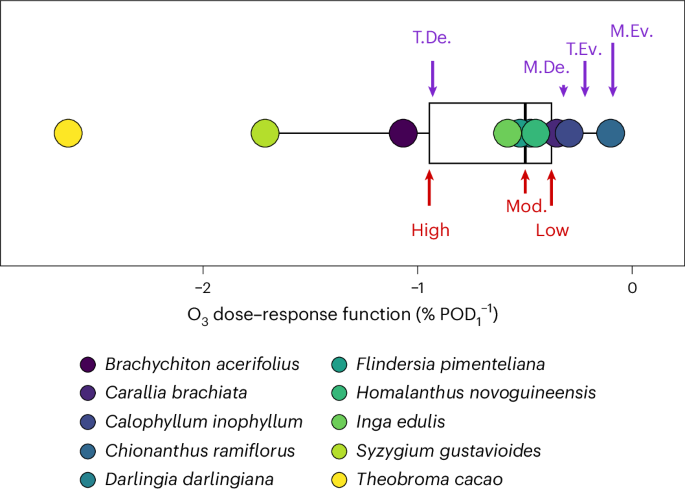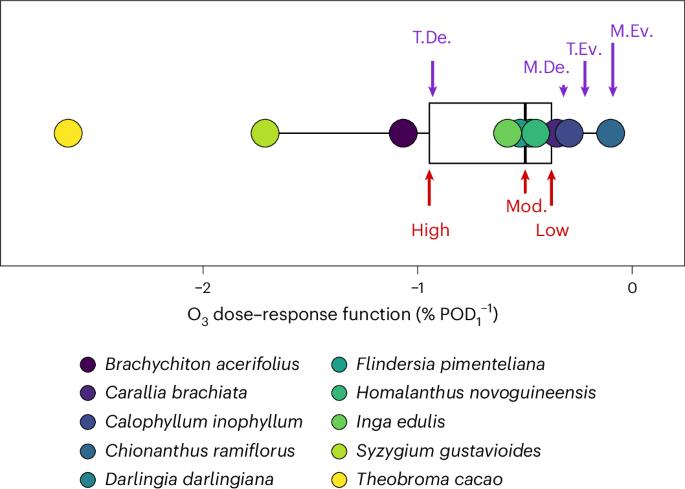地面臭氧暴露导致热带森林生产力降低和碳减少
IF 15.7
1区 地球科学
Q1 GEOSCIENCES, MULTIDISCIPLINARY
引用次数: 0
摘要
众所周知,人类活动造成的地面臭氧升高会降低植物生产力,但其对热带森林的影响仍不清楚。在这里,我们估算了臭氧暴露的增加对热带雨林生产力和全球碳循环的影响。我们通过实验测量了各种热带树种对臭氧的敏感性,然后将这些数据纳入动态全球植被模型。我们发现,目前人为产生的臭氧导致所有热带森林的年净初级生产力(NPP)大幅下降,某些地区受到的影响尤为严重。例如,亚洲的净初级生产力下降了 10.9%(7.2-19.7%)。根据我们的计算,自 2000 年以来,生产力的下降导致每年碳吸收的累积损失为 0.29 PgC,相当于 21 世纪热带当代年度陆地碳汇的约 17%。我们还发现,目前和未来的森林恢复区域受到臭氧升高的影响尤为严重。减少热带地区臭氧形成的未来社会经济途径将通过缓解当前完整森林和森林恢复地区的臭氧影响,为全球碳预算带来益处,而这些地区是减缓大气中二氧化碳上升的关键陆地区域。本文章由计算机程序翻译,如有差异,请以英文原文为准。


Reduced productivity and carbon drawdown of tropical forests from ground-level ozone exposure
Elevated ground-level ozone, a result of human activity, is known to reduce plant productivity, but its influence on tropical forests remains unclear. Here we estimate how increased ozone exposure has affected tropical-forest productivity and the global carbon cycle. We experimentally measure the ozone susceptibility of various tropical tree species, and then incorporate these data into a dynamic global vegetation model. We find that current anthropogenic-derived ozone results in a substantial decline in annual net primary productivity (NPP) across all tropical forests, with some areas being particularly impacted. For example, Asia sees losses of 10.9% (7.2–19.7%) NPP. We calculate that this productivity decline has resulted in a cumulative loss in carbon drawdown of 0.29 PgC per year since 2000, equating to ~17% of the tropical contemporary annual land carbon sink in the twenty-first century. We also find that areas of current and future forest restoration are disproportionately affected by elevated ozone. Future socioeconomic pathways that reduce ozone formation in the tropics will incur benefits to the global carbon budget by relieving the current ozone impacts seen across both intact forest and areas of forest restoration, which are critical terrestrial regions for mitigation of rising atmospheric carbon dioxide. Anthropogenic ground-level ozone substantially reduces the productivity of tropical forests and so their carbon drawdown, according to ozone susceptibility experiments and dynamic global vegetation modelling.
求助全文
通过发布文献求助,成功后即可免费获取论文全文。
去求助
来源期刊

Nature Geoscience
地学-地球科学综合
CiteScore
26.70
自引率
1.60%
发文量
187
审稿时长
3.3 months
期刊介绍:
Nature Geoscience is a monthly interdisciplinary journal that gathers top-tier research spanning Earth Sciences and related fields.
The journal covers all geoscience disciplines, including fieldwork, modeling, and theoretical studies.
Topics include atmospheric science, biogeochemistry, climate science, geobiology, geochemistry, geoinformatics, remote sensing, geology, geomagnetism, paleomagnetism, geomorphology, geophysics, glaciology, hydrology, limnology, mineralogy, oceanography, paleontology, paleoclimatology, paleoceanography, petrology, planetary science, seismology, space physics, tectonics, and volcanology.
Nature Geoscience upholds its commitment to publishing significant, high-quality Earth Sciences research through fair, rapid, and rigorous peer review, overseen by a team of full-time professional editors.
 求助内容:
求助内容: 应助结果提醒方式:
应助结果提醒方式:


